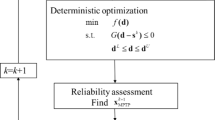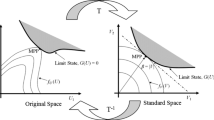Abstract
Compared to the traditional deterministic optimization based on safety factors, the probabilistic structural design optimization (PSDO) is considered to be a more rational design philosophy because of reasonable account of uncertainties in material properties, loading, boundary condition and geometry, and even mathematical representation of the system model. However, it is well known that the computation for PSDO can be prohibitive when the associated function evaluation is expensive. As a result, many approximate PSDO methods have been developed in recent literatures. In previous works, we developed two sequential approximate programming (SAP) strategies for PSDO based on reliability index approach (RIA) and performance measure approach (PMA). In PMA with SAP, a sequence of approximate programming of PSDO was formulated and solved before the final optimum was located. In each subprogramming, rather than relying on direct linear Taylor expansion of the probabilistic performance measure (PPM), we developed a formulation for approximate PPM at the current design point and used its linearization instead. The approximate PPM and its sensitivity were obtained by approximating the optimality conditions in the vicinity of the minimum performance target point (MPTP). The present paper further elaborates the SAP for PMA. In addition to detailed description of the algorithm, we present error analysis and show that in the ɛ-vicinity of optimum design and corresponding MPTP, the difference between the Taylor expansion of PPM and the linear expansion of approximate PPM is of higher order of ɛ. Four examples are optimized by six algorithms appearing in recent literatures for efficiency comparison. The effect of target reliability index and statistical distribution of random variables on the comparison is discussed. The third example shows that PMA with SAP performs well even for the problem for which reliability index calculation by first order reliability method (FORM) fails. Finally, the fourth example with 144 probabilistic constraints is shown to demonstrate the effectiveness of PMA with SAP. All example results illustrate that with the algorithm PMA with SAP, we get concurrent convergence of both design optimization and probabilistic performance measure calculation, which agrees well with the error analysis.
Similar content being viewed by others
References
Chandu SVL, Grandi RV (1995) General purpose procedure for reliability based structural optimization under parametric uncertainties. Adv Eng Softw 23(1):7–14
Cheng GD (1984) Basic of structural optimization and design. China Waterpower, Beijing
Cheng GD, Xu L, Jiang L (2006) Sequential approximate programming strategy for reliability-based optimization. Comput Struct 84(21):1353–1367
Du X, Chen W (2002) Sequential optimization and reliability assessment method for efficient probabilistic design. In: ASME Design Engineering Technical Conf. (held in Montreal) DEIC2002/DAC-34127
Enevoldsen I, Sorensen JD (1994) Reliability-based optimization in structural engineering. Struct Saf 15(3):169–196
Gu L, Yang RJ (2003) Recent applications on reliability-based optimization of automotive structures. SAE World Congress and Exhibition, 2003-01-0152
Hasofer AM, Lind NC (1974) An exact and invariant first order reliability format. J Eng Mech 100(EM1):111–121
Hohenbichler M, Rackwitz R (1981) Non-normal dependent vectors in structural safety. J Eng Mech 107(EM6):1227–1249
Lombardi, M (1994) Ottimizzazione struttuurale: metodo a due passi e applicazioni a strutture in materiale composito. Doctorate dissertation, Polytechnic of Milan, Italy (in Italian)
Nikolaidis E, Burdisso R (1988) Reliability based optimization: a safety index approach. Comput Struct 28(6):781–788
Royset JO, Kiureghian AD, Polak E (2001) Reliability-based optimal structural design by the decoupling approach. Reliab Eng Syst Saf 73(3):213–221
Thomas H, Vanderplaats G, Shyy Y-K (1992) A Study of Move Limit Adjustment Strategies in the Approximation Concepts Approach to Structural Synthesis. Proc. 4th AIAA/USAF /NASA/OAI Symposium on Multidisciplinary Analysis and Optimization, Cleveland, OH, AIAA-92-4839
Torng TY, Yang RJ (1993) An advanced reliability based optimization method for robust structural system design. Proc. 34th AIAA/ASME/ASCE/AHS/ASC Structures, Structural Dynamics, and Material Conference, AIAA-93-1443-CP
Tu J, Choi KK, Park YH (1999) A new study on reliability-based design optimization. J Mech Des 121(4):557–564
Wang LP, Grandhi RV (1994) Efficient safety index calculation for structural reliability analysis. Comput Struct 52(1):103–111
Wang LP, Grandhi RV (1996) Safety index calculation using intervening variables for structural reliability analysis. Comput Struct 59(6):1139–1148
Wang L, Kodiyalam S (2002) An efficient method for probabilistic and robust design with non-normal distributions. In: Proc. 43rd AIAA SDM Conf. (held in Denver)
Wu YT, Millwater HR, Cruse TA (1990) Advanced probabilistic structural analysis method for implicit performance function. AIAA J 28(9):1663–1669
Xu L, Cheng GD, Yi P (2005) Tolerance synthesis by a new method for system reliability-based optimization. Eng Optim 37(7):717–732
Yang RJ, Gu L (2004) Experience with approximate reliability-based optimization methods. Struct Multidiscipl Optim 26(2):152–159
Yang RJ, Chuang C, Gu L, Li G (2005) Experience with approximate reliability-based optimization methods II: an exhaust system problem. Struct Multidiscipl Optim 29:488–497
Yi P, Cheng GD, Jiang L (2007) A sequential approximate programming strategy for performance-measure-based probabilistic structural design optimization. Struct Saf (in press)
Youn BD, Choi KK (2004) An investigation of nonlinearity of reliability-based design optimization approaches. J Mech Des 126:403–411
Youn BD, Choi KK, Park YH (2003) Hybrid analysis method for reliability-based design optimization. J Mech Des 125(2):221–232
Author information
Authors and Affiliations
Corresponding author
Rights and permissions
About this article
Cite this article
Yi, P., Cheng, G. Further study on efficiency of sequential approximate programming for probabilistic structural design optimization. Struct Multidisc Optim 35, 509–522 (2008). https://doi.org/10.1007/s00158-007-0120-8
Received:
Revised:
Published:
Issue Date:
DOI: https://doi.org/10.1007/s00158-007-0120-8




